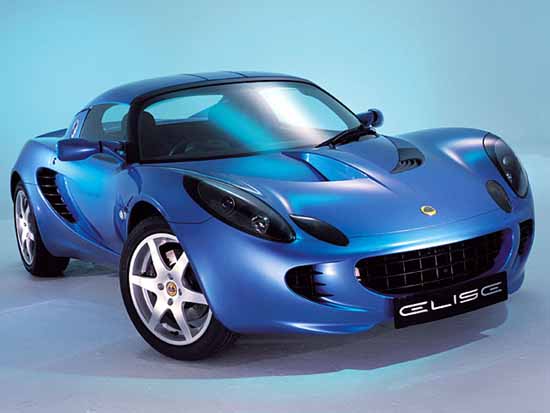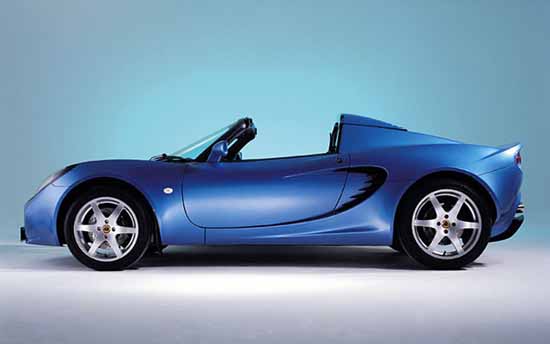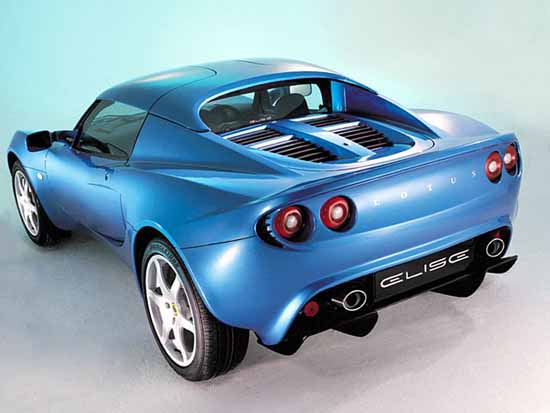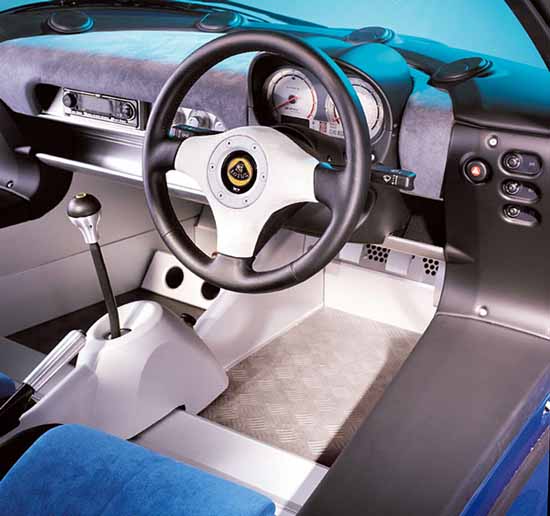
(See also Series 2 for current press pictures, photographs of the Series 2 on the manufacturing line, and on the track.)
From: Morgan, John P <JPMorgan@lotuscars.co.uk>
To: "'SANDSMUSEUM.COM'" Date: Monday, October 9, 2000 3:58 AM
Subject: Lotus Life News
Dear MR MICHAEL SANDS
News from Lotus for Members of Lotus Life, the Official Lotus Club.
Today, October 9th, Lotus have officially announced a new Elise which will be shown at the UK Motor Show later this month. Below is the press release issued today, there will be more information in the next issue of Lotus Life or from October 16th it will be on the Lotus web site (www.lotuscars.co.uk):
John P Morgan Manager, Lotus Life the Official Lotus Club
THE ELISE - IMPROVING ON AN ICON
Fresh styling and enhanced dynamics keep the Elise ahead of the pack
For more than five years the Lotus Elise has been the undisputed sportscar king. Winning countless awards for its technical innovation, handling prowess and fun to drive purity, its fan base includes anyone who's ever sat behind its steering wheel.
Some champions quit while they're ahead. Not Lotus. It's raising its game to meet new challenges. And now the Elise looks like hanging on to its title as 'the world's best handling sports car' for years to come.
An all-encompassing evolution of the previous car, the Elise has fresh styling inside and out with improved aerodynamics for greater high-speed stability. Newly designed chassis systems provide superior ride and handling with higher levels of roadholding, sharper steering, more powerful brakes, quicker throttle response and overall greater functionality. Together with new manufacturing processes for an all-round upgrade in quality.
It's a more mature car, yet it has lost none of its 'Lotus-ness', nor any of the magic associated with the name Elise - light, fast, agile, and above all, more fun than ever.
Production of the Elise begins this October in an all-new manufacturing facility at Hethel, the Lotus headquarters. And with all of the improvements and an enhanced level of standard equipment, prices start from £22,995, just a fraction more than the previous car.

Keeping up appearances Style is an Elise trademark. The Elise look is instantly recognisable. When design work started there was universal agreement within Lotus that its looks should be an evolution of the existing form. But looks are not the only ground breaking feature of the Elise design.
The Elise will make its mark in history as the first Lotus created on computer. This advanced digital process translates concept form to full size reality in a fraction of the time, dramatically reducing styling and tooling design effort and allowed the project to be completed in under one year.
As with so many Lotus models, the design brief for the Elise was to produce a shape both modern and timeless, and as ever, the principles of form following function were rigorously applied as the Lotus Design Team crafted the detail into the final design. But whereas the previous Elise combines subtle curves and rounded shapes, the Elise now has sharper, more aggressive edges. It sits closer to the ground (by 10mm), its wheel and tyres more fully fill the wheelarches and its rear haunches are more pronounced. Head-on it has a meaner, more menacing look, and from every angle it portrays speed, motion and energy. As every Lotus should.
The Principle Designer in charge of the Elise design, Steve Crijns, explains some of the changes. "We wanted to create a shape that would reflect an incredible driving experience. The car has to look a hell of a lot more exciting than your everyday 2 seater cabrio. But we also wanted to be honest and not have any features just for stylistic effect. We started the design by shrink wrapping the bodywork around the mechanical components. Unnecessary bulk, even if it's for stylistic effect, creates weight, and a Lotus must be light. Very early in the design phase the full size clay model went to the wind tunnel where the rear spoiler and rear diffuser were created to optimise downforce without causing drag."

As with everything on a Lotus, the diffuser is not just a cosmetic enhancement, the Elise aerodynamics were developed to balance downforce over both the front and rear axles. This aids high-speed stability and has been achieved without increasing drag in soft or open top configurations. In fact, the lowered roofline and new hard top actually reduce the drag figures.
Crijns goes on to add "We wanted to emphasise that the Elise is rear wheel drive by increasing the power and volume of the bodywork over the rear wheels. Lowering the bonnet and reducing the waistline accentuates the width at the rear. Also, having larger diameter wheels at the rear than those at the front helps with this effect. In total, the design details of the Elise pay homage to the very best elements of classic sportscars. Add the design cues from the motorsport world, such as the fuel filler cap and the bold treatment of the rear diffuser, and the result speaks for itself".
Recent Lotus designs have also helped shape the Elise. Its sealed unit headlamp pack has a strong family link to the exclusive 340R, while the quartet of multi-function round rear lamps echo those of Project M250.
The rear tail section of the Elise is slightly longer than that of the previous car, this increased length and use of the full width of the rear bodywork creates a much increased luggage space area.
The revised hood design still flows aft over the rear roll-over bar and onto the Elise's tapered rear buttresses. The soft-top has been redesigned to simplify assembly so it's much easier to remove and store in the boot. The new hard-top has a novel design. 'Gullwing' roof panels, which can be easily opened to improve access to the cockpit, and removed, and stored in the boot, to turn the Elise into a targa-top for those days when the sun looks friendly but the air temperature isn't.
Every body panel on the Elise is new and they are now made using polished high grade steel tools by French specialist, Sotira. This provides world class composite panels of a superior quality level over the traditional hand-laid glassfibre process, it also allows them to be thinner and lighter. This helps to explain why the Elise, despite its increased length and additional specifications, weighs in at just 710kg.
Inside story Access to the Elise cockpit has been improved thanks to the re-profiled sill design adding 40mm to the opening of the door aperture and reducing the width of the sill, whilst still retaining its impressive chassis stiffness. And as already outlined, access is even easier with the optional 'Gullwing' hard-top in place.
The exposed aluminium of the Elise's chassis tub is still one of the dominant features of the interior, but there's also a far more integrated and harmonious design sense to all of the other interior components. Overall, the effect remains one of thoughtful minimalism, necessity mixed with style.
All the controls are now of a high quality bespoke design, much of it using aluminium. The quest for enhanced quality even extends to concealed items, such as the window lift mechanism inside the doors.
One of the Elise's most distinctive features, the Stack electronic instrumentation, is now updated with new graphics. The race-style dials are now housed beneath a redesigned binnacle and blue back lighting adds to the jewel like design detail. Links between the Elise and the track have always been strong, and the ambience of the facia and trim with the chassis tub sides provoke a strong sense of being seated in a real sportscar.
Revised seats head up a list of interior refinements and optional equipment that also includes a new rear bulkhead trim incorporating improved noise insulation and twin audio speakers. Additional speakers can be located at the outer edges of the facia, giving, for the first time in the Elise, the option of a four-speaker system. Storage space was one of the concerns of the design team and this has been addressed. An optional full-width curved shelf runs beneath the facia and features ingenious extruded aluminium shelf-dividers which can be moved to firmly store objects such as drinks cans and mobile phones.
In response to the differing needs of the Elise customer base, the interior trim and other features will now be offered in two distinct option packages above the standard car: Sports Touring and Race Tech. Both Sports Touring and Race Tech options are a set price of £3,195 and £2,995 respectively over the standard list price.
Race Tech focuses on functionality and uses racecar materials to create a sporty interior without compromise. Sports Touring employs Nubuck leather for the padded seats, door trims and facia as well as carpets to offer a high level of refinement for long distance journeys.
Achieving the impossible - an improved chassis The Elise, "best handling car" in the business. How do you top it? Skill, experience, and a lot of dedicated hard work.
Spring rates have been increased (35Nm-1 on the front springs and 50 Nm-1 at the rear), and thanks to the adoption of Bilstein high pressure monotube dampers (not to mention hundreds of hours of development driving to fine-tune the set-up) the handling performance and ride quality are much improved. Roll rates are slower than before, making the Elise more agile yet more composed and stable through corners, and less pitch sensitive than before.
Bridgestone have jointly developed with Lotus the unique Potenza RE040 tyres (175/55R16 front and 225/45R17 rear) in parallel with the suspension design and tuning process. The Lotus Ride and Handling team have maximised the ability to hone the chassis and tyre characteristics to provide an overall increase in performance.
The Elise is now equipped with not only more outright grip, greater high speed stability and better progression at the limit but improved steering feel, feedback and response. And a wet road grip limit capability that is much closer to the performance in the dry.
The result is that overall the Elise feels much quicker, livelier, more responsive, predictable and even more forgiving, but most importantly more fun to drive.

Powertrain - the same, but subtly different Sitting snug behind the cockpit is the same 1.8-litre 122PS / 120bhp K series engine. It's still the lightest power unit suitable for the application and it produces capable torque and a more than adequate power output for such a lightweight car.
However, there are significant improvements. The engine management system has been upgraded to pass the latest Euro 3 emissions regulations (which go through to at least 2004) - this includes fitting Lotus developed on-board engine diagnostics. Another benefit of fitting the Lotus bespoke engine management system is that the engine now has been tuned to offer improved throttle response and driveability, which combined with the close ratio transmission, now standard fitment, gives the Elise a sense of much increased performance and a sportier feel.
Because the Elise runs on larger diameter wheels and tyres, 16in at the front, 17in at the rear, it uses close gearing as standard to enhance overall acceleration feel and driveability. Top speed is 125mph, and the 0-60mph time is achieved in 5.7sec.
The legend grows The trouble with icons is that they're difficult to replace. But not impossible. The Elise proves that by concentrating on the important issues, understanding the needs of customers, and through an instinctive appreciation of the finer points of vehicle dynamics, you can improve, even on the best.
The original Elise created a legend; its successor will ensure that the Elise reputation will continue to grow.
